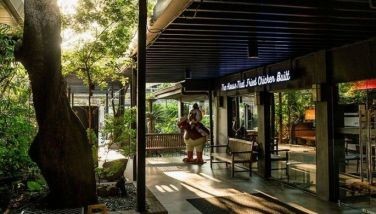Mini reviews
February 21, 2007 | 12:00am
Tenor Abdul Candao, who is based in Vienna where he teaches at the Conservatory, gave his listeners a musical adventure at the F. Santiago Hall by rendering little-known songs by Charles Ives, with pianist Najib Ismail as assisting artist. The American composer is not credited, except by musicologists, for being a precursor of Stravinsky (for his poly-rhythms), Bartok (for his discords), Henry Cowell (for his tone clusters), Schoenberg (for his atonality) and Boulez (for his music of chance).
Ives’ brief songs greatly varied in style, rhythm and content. Candao’s enunciation was remarkably clear, his beautiful phrasing shaping the substance of each piece.
In Ives’ songs as also in Schubert’s in Italian, the tenor’s voice did not particularly impress, its timber somewhat wanting in roundness and sonority. But as the vocalist went on, interpreting Donizetti’s two arias and another from Il Duca d’Alba  one of two operas which were not performed during the composer’s lifetime  his voice gained in sonority and volume, with the rendition becoming lustier and more vibrant, in keeping with the nature of the selections. The listeners noted symmetry and elegance of form as well as freshness and spontaneity in Dvorak’s aria from Ruselka, the singing growing even more expansive and expressive.
However, it was in the kundimans by Silos and Cuenco that Candao’s performance reached its fullest splendor  that is, its maximum volume and emotional intensity. The rapturous applause led to three encores.
Pianist Ismail established seamless and impeccable rapport with the vocalist. His musicianship was of the most meticulous and his sensitive artistry coaxed ineffably delicate and exquisite tones from the piano.
Appropriately, as a Valentine’s Day offering, the St. Paul U. Manila College of Music presented at the Fleur-de-lis Theater Najib Ismail and Mary Ann Espina in piano duets, and a vocal quartet consisting of soprano Thea Perez, mezzo-soprano Nenen Espina, tenor Ronan Ferrer and baritone Noel Azcona in a series of love songs (Liebeslieder).
It is no idle claim that Najib Ismail is considered "one of the most sought-after collaborative pianists in the country" whether as assisting artist to a singer or partner of another pianist  as he was that night of Mary Ann Espina in Mozart’s Sonata in D Major, Debussy’s Petite Suite, Dvorak’s Three Slavonic Dances and Brahms’ Three Hungarian Dances.
Theirs was the closest ensemble-playing imaginable; theirs was a meeting of minds in matters of technique and expression. Sparkle and a playful spirit were conveyed in Mozart’s composition. Form and harmony, rhythm and color, rather than melody, correctly surfaced in Debussy’s Suite. Vigor and drive  these emphasized by dense and massive chords  were demonstrated in the dances as were varying moods which ranged from the soulful, poignant and mournful to the spritely, gay and zestful.
Ismail and Espina played as one in style and spirit, with Ismail occasionally showing a slight edge in skill, musicianship and expressivity. But together, they made marvelous music from start to finish.
They continued their brilliant teamwork in Brahms’ Liebeslieder Waltzes Vol. 1. The vocal quartet seemed rather uneven in performance, with the voices of Azcona and Perez often soaring above those of Ferrer and Nenen Espina. But the interpretation itself left hardly anything to be desired. The singers infused vitality and exuberance into their performance, showing wonderfully controlled dynamics in both piano and fortissimo passages, while sustaining the "romantic" mood throughout. The women were in red gowns as though to deepen this mood even more.
Tonight, the Italian Ruggero Barbieri, former music director-conductor of the Philippine Philharmonic Orchestra, will wield the baton over the Four Seasons Chamber Orchestra in a post-dinner concert at the Trader’s Hotel.
Barbieri leaves for Europe to conduct Verdi operas in May and June in his native Bergamo and neighboring cities.
Yesterday evening, outstanding pianist Jonathan Coo and equally outstanding flutist Ray Sison gave a recital at the GSIS auditorium to inaugurate the venue as a performance hall.
Ives’ brief songs greatly varied in style, rhythm and content. Candao’s enunciation was remarkably clear, his beautiful phrasing shaping the substance of each piece.

In Ives’ songs as also in Schubert’s in Italian, the tenor’s voice did not particularly impress, its timber somewhat wanting in roundness and sonority. But as the vocalist went on, interpreting Donizetti’s two arias and another from Il Duca d’Alba  one of two operas which were not performed during the composer’s lifetime  his voice gained in sonority and volume, with the rendition becoming lustier and more vibrant, in keeping with the nature of the selections. The listeners noted symmetry and elegance of form as well as freshness and spontaneity in Dvorak’s aria from Ruselka, the singing growing even more expansive and expressive.
However, it was in the kundimans by Silos and Cuenco that Candao’s performance reached its fullest splendor  that is, its maximum volume and emotional intensity. The rapturous applause led to three encores.
Pianist Ismail established seamless and impeccable rapport with the vocalist. His musicianship was of the most meticulous and his sensitive artistry coaxed ineffably delicate and exquisite tones from the piano.
It is no idle claim that Najib Ismail is considered "one of the most sought-after collaborative pianists in the country" whether as assisting artist to a singer or partner of another pianist  as he was that night of Mary Ann Espina in Mozart’s Sonata in D Major, Debussy’s Petite Suite, Dvorak’s Three Slavonic Dances and Brahms’ Three Hungarian Dances.
Theirs was the closest ensemble-playing imaginable; theirs was a meeting of minds in matters of technique and expression. Sparkle and a playful spirit were conveyed in Mozart’s composition. Form and harmony, rhythm and color, rather than melody, correctly surfaced in Debussy’s Suite. Vigor and drive  these emphasized by dense and massive chords  were demonstrated in the dances as were varying moods which ranged from the soulful, poignant and mournful to the spritely, gay and zestful.
Ismail and Espina played as one in style and spirit, with Ismail occasionally showing a slight edge in skill, musicianship and expressivity. But together, they made marvelous music from start to finish.
They continued their brilliant teamwork in Brahms’ Liebeslieder Waltzes Vol. 1. The vocal quartet seemed rather uneven in performance, with the voices of Azcona and Perez often soaring above those of Ferrer and Nenen Espina. But the interpretation itself left hardly anything to be desired. The singers infused vitality and exuberance into their performance, showing wonderfully controlled dynamics in both piano and fortissimo passages, while sustaining the "romantic" mood throughout. The women were in red gowns as though to deepen this mood even more.
Barbieri leaves for Europe to conduct Verdi operas in May and June in his native Bergamo and neighboring cities.
Yesterday evening, outstanding pianist Jonathan Coo and equally outstanding flutist Ray Sison gave a recital at the GSIS auditorium to inaugurate the venue as a performance hall.
BrandSpace Articles
<
>
- Latest
- Trending
Trending
Latest
Latest

By SKETCHES | By Ana Marie Pamintuan | 1 day ago

By THE CORNER ORACLE | By Andrew J. Masigan | 1 day ago
Recommended





















